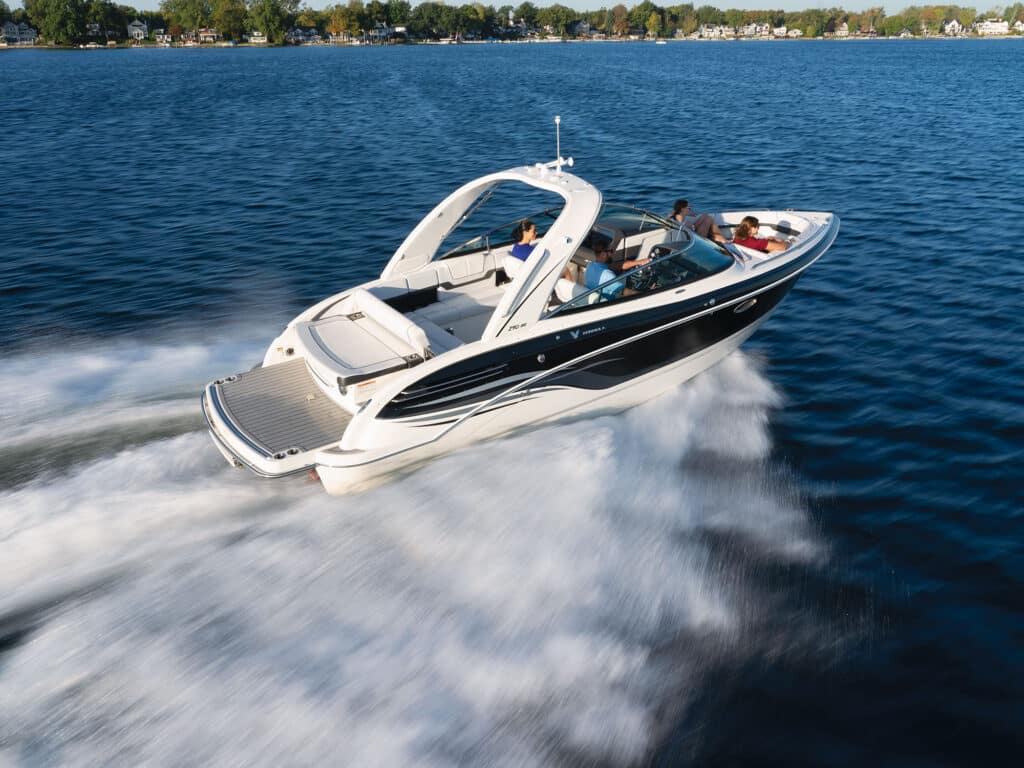SB Television
Trimming Your Boat for Safety, Comfort and Efficiency
 There are numerous specific boat-power-conditions scenarios in which changing the boat’s trim will change the safety, comfort and efficiency of the ride.
Bill Doster
There are numerous specific boat-power-conditions scenarios in which changing the boat’s trim will change the safety, comfort and efficiency of the ride.
Bill Doster
Safety, comfort and efficiency rank as the top three promises of good seamanship. Your boat’s trim—both fore and aft, and across the beam—affects this trinity. In turn, you can affect boat trim to better deliver on the promises of seamanship.
There might be trade-offs in using these techniques, and I am not implying that trim alone addresses all ills that can threaten safety, comfort and efficiency. Hopefully, the following examples spark you to extrapolate and apply the principle of trim as a tool you can use when boating.
Head seas rank high in many discussions regarding comfort aboard boats. We can “smooth out the bumps” for a given speed by trimming down the bow. You can do so by applying the trim tabs. Or you can bring the bow down with outboards or sterndrives by trimming in the drives or engines (or trimming “down,” as some like to say). The jolts will be less shocking. But speed and fuel efficiency will also decrease, due to increased drag. Furthermore, you might get a wetter ride with the bow trimmed down because the hull will break water farther forward. Too much down-trim combined with too much speed can even create a safety hazard because your boat might start to bow-steer or take green water over the bow. These reasons mandate adjusting trim to refine ride quality incrementally. That way, you can balance the trade-offs.
When running down-sea, it’s beneficial to keep the bow up. Remember, trim tabs can only bring the bow down; they do not lift the bow. Outboard and sterndrive boats can trim out the powerplants to lift the bow. (An inboard boat’s shaft angle creates a natural bow-up attitude.) Keeping the bow up helps inhibit a boat from getting pushed into the trough ahead of a wave. Should that happen, bow steering, a broach (turning sideways to the seas), or even a capsize could result. Often, I find myself riding the trim, maintaining moderate trim as I approach the wave, adding a little more up-trim as I crest it, and then trimming back down a bit leaving the trough and approaching the back of the next roller. This allows the boat to react better to the energy input from the wave while helping to maximize engine thrust when it’s most needed—climbing the back of a wave.
Read Next: Key Tips for Crew Communication
Another scenario where trim can create ride comfort is when operating a boat with a deep-V hull in a stiff crosswind. For reasons of physics beyond the scope of this article, a V-hull on plane tends to lean into a stiff beam wind. The list creates discomfort because the boat is coming down on the hull flats rather than the V. By trimming down the side of the boat opposite the lean, the list can be eliminated. We can use one trim tab, trim one engine, or move crew and gear around to do so. This phenomenon is often exacerbated by lean induced by prop torque. Indeed, prop torque itself often causes a boat to list. In that case, trimming out the drive or engine can mitigate the lean. Why? Simply put, the twisting effect of the prop changes with changes in drive trim.
There exists a multitude of specific boat-power-conditions scenarios in which changing the boat’s trim will change the safety, comfort and efficiency of the ride. With experience and time, you’ll learn to dial in your boat’s ride, quickly and confidently balancing the variables to best suit the moment.
The post Trimming Your Boat for Safety, Comfort and Efficiency appeared first on Boating Mag.
- Home
- About Us
- Write For Us / Submit Content
- Advertising And Affiliates
- Feeds And Syndication
- Contact Us
- Login
- Privacy
All Rights Reserved. Copyright , Central Coast Communications, Inc.